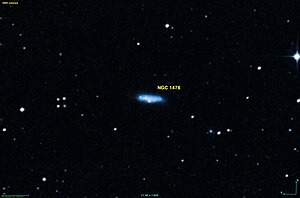NGC 1476
| Galaxy NGC 1476 |
|
|---|---|

|
|
| AladinLite | |
| Constellation | Pendulum clock |
|
Position equinox : J2000.0 , epoch : J2000.0 |
|
| Right ascension | 03 h 52 m 08.8 s |
| declination | -44 ° 31 ′ 57 ″ |
| Appearance | |
| Morphological type | Sa? / pec |
| Brightness (visual) | 13.1 mag |
| Brightness (B-band) | 14.0 mag |
| Angular expansion | 1.4 ′ × 0.6 ′ |
| Position angle | 86 ° |
| Surface brightness | 12.8 mag / arcmin² |
| Physical data | |
| Redshift | 0.005623 +/- 0.000023 |
| Radial velocity | 1686 +/- 7 km / s |
|
Stroke distance v rad / H 0 |
(69 ± 5) · 10 6 ly (21.1 ± 1.5) Mpc |
| history | |
| discovery | John Herschel |
| Discovery date | December 14, 1835 |
| Catalog names | |
| NGC 1476 • PGC 14001 • ESO 035031-4440.8 • MCG -07-09-001 • IRAS 03504-4440 • 2MASX J03520773-4431585 • SGC 035031-4440.8 • GC 785 • h 2591 • | |
NGC 1476 is a spiral galaxy of Hubble type Sa in the constellation pendulum clock on the southern sky , the 69 million light-years from an estimated Milky Way is removed.
The object was discovered on December 14, 1835 by John Herschel .
